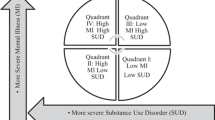Abstract
The rate of closure among US substance abuse treatment facilities in the private sector is considerable, further reducing access to treatments that are already in short supply in many locales. Using a nationally representative sample of 450 substance abuse treatment centers, this research considers the extent to which specific types of service diversification reduce the likelihood of treatment center closure in the private sector. Over the study period, 26.4% of centers ceased to offer substance abuse treatment services. There was mixed evidence that centers offering a more diversified array of services had a lower likelihood of closure. Specifically, the number of treatment tracks tailored to specific demographic groups was negatively associated with the likelihood of closure. There was a positive association between closure and offering an inpatient psychiatric program. These findings suggest that there may be strategic benefits in expanding services to meet the needs of diverse clientele.
Similar content being viewed by others
References
Johnson JA, Roman PM. Predicting closure of private substance abuse treatment facilities.Journal of Behavioral Health Services & Research. 2002;29:115–125.
Covin JG, Slevin DP. Strategic management of small firms in hostile and benign environments.Strategic Management Journal. 1989;10:75–87.
Fichman RG. The role of aggregation in the measurement of IT-related organizational innovation.MIS Quarterly. 2001;25:427–455.
Ramanujam V, Varadarajan P. Research on corporate diversification: a synthesis.Strategic Management Journal. 1989;10:523–551.
Haveman HA. Between a rock and a hard place: organizational change and performance under conditions of fundamental environmental transformation.Administrative Science Quarterly. 1992;37:48–75.
Christensen CM.The Innovator's Dilemma: When New Technologies Cause Great Firms to Fail. Boston: Harvard Business School Press; 1997.
Hannan MT, Freeman J. Structural inertia and organizational change.American Sociological Review. 1984;49:149–164.
Hannan MT, Freeman J.Organizational Ecology. Cambridge, Mass: Ballinger; 1989.
Lamb S, Greenlick MR, McCarty D, eds.Bridging the Gap Between Practice and Research: Forging Partnerships With Community-based Drug and Alcohol Treatment. Washington, DC: National Academy Press; 1998.
Knudsen HK, Roman PM. Modeling the use of innovations in private treatment organizations: the role of absorptive capacity.Journal of Substance Abuse Treatment. 2004;26:353–361.
Liddle HA, Rowe CL, Quille TJ, et al. Transporting a research-based adolescent drug treatment into practice.Journal of Substance Abuse Treatment. 2002;22:231–243.
Martin GW, Herie MA, Turner BJ, et al. A social marketing model for disseminating research-based treatments to addictions treatment providers.Addiction. 1998;93:1703–1715.
Roman PM, Johnson JA. Adoption and implementation of new technologies in substance abuse treatment.Journal of Substance Abuse Treatment. 2002;22:211–218.
White WL.Slaying the Dragon: The History of Addiction and Recovery in America. Bloomington, Ill: Chestnut Health Systems; 1998.
Roman PM, Johnson JA, Blum TC. The transformation of private alcohol problem treatment: Results from a national study.Advances in Medical Sociology. 2000;7:321–342.
Mechanic D, McAlpine DD. Mission unfulfilled: potholes on the road to mental health parity.Health Affairs. 1999;18(5):7–21.
Taleff MJ, Swisher JD. The seven core functions of a master's level alcohol and other drug counselor.Journal of Alcohol and Drug Education. 1997;42(3):1–17.
Blum TC, Roman PM, Shane S. Alcoholism treatment center death: interorganizational linkages in health care. In: Reynolds P, McDougall PP, Birley S, eds.Frontiers in Entrepreneurial Research. Boston: Babson College Center for Entrepreneurial Studies; 1996:16–29.
Knudsen HK, Johnson JA, Roman PM, et al. Rural and urban similarities and differences in private substance abuse treatment centers.Journal of Psychoactive Drugs. 2003;35:511–518.
Etheridge RM, Smith JC, Rounds-Bryant JL, et al. Drug abuse treatment and comprehensive services for adolescents.Journal of Adolescent Research. 2001;16:563–589.
Hser YI, Grella CE, Hubbard RL, et al. An evaluation of drug treatments for adolescents in 4 US cities.Archives of General Psychiatry. 2001;58:689–695.
Ashley OS, Marsden ME, Brady TM. Effectiveness of substance abuse treatment programming for women: a review.The American Journal of Drug and Alcohol Abuse. 2003;29(1):19–53.
Drain M, Godkin L, Valentine, S. Examining closure rates of rural hospitals: an assessment of a strategic taxonomy.Health Care Management Review. 2001;26(4):27–51.
Lee SD, Alexander JA. Managing hospitals in turbulent times: do organizational changes improve hospital survival?Health Services Research. 1999;34:923–946.
Chandler AD.Strategy and Structure: Chapters in the History of Industrial Enterprise. Cambridge, Mass: MIT Press, 1962.
Stinchcombe AL. Social structure and organizations. In: March JG, ed.Handbook of Organizations. Chicago: Rand McNally; 1965:142–193.
Jawahar IM, McLaughlin GL. Toward a descriptive stakeholder theory: an organizational life cycle approach.Academy of Management Review. 2001;26:397–414.
Rogers EM.Diffusion of Innovations. 4th ed. New York: Free Press; 1995.
Scott WR.Institutions and Organizations. 2nd ed. Thousand Oaks, Calif: Sage; 2001.
Damanpour F. Organizational innovation: a meta-analysis of effects of determinants and moderators.Academy of Management Journal. 1991;34:555–590.
Milne SH, Blum TC, Roman PM. Qualith management in a health care setting: a study of substance abuse treatment centers.Advances in the Management of Organizational Quality. 2000;5:215–248.
Mee-Lee DL, Gartner L, Miller MM, et al.Patient Placement Criteria for the Treatment of Substance-Related Disorders. 2nd ed. Chevy Chase, Md: American Society of Addiction Medicine; 1996.
Bantel KA. Technology-based “adolescent” firm configurations: strategy identification, context, and performance.Journal of Business Venturing. 1998;13:205–230.
Davis C. Entrepreneurial leader style and organizational performance: the moderating effects of life cycle and profit status in health care organizations. Paper presented at: The Annual Meeting of the Academy of Management; August 7, 2000; Toronto, Ontario, Canada.
Allison P.Event History Analysis: Regression for Longitudinal Data. Beverly Hills, Calif: Sage; 1984.
Pfeffer J, Salancik GR.The External Control of Organizations: A Resource Dependence Perspective. New York: Harper & Row; 1978.
Sheppard JP. A resource dependence approach to organizational failure.Social Science Research. 1995;24:28–62.
Merrick EL, Garnick DW, Horgan CM, et al. Benefits in behavioral carve-out plans of Fortune 500 firms.Psychiatric Services. 2001;52:943–948.
Perry JL, Rainey HG. The public-private distinction in organization theory: a critique and research strategy.Academy of Management Review. 1988;13:182–201.
Food and Drug Administration. New drug to treat alcoholism.FDA Consumer. 2004;38(5):3.
Fiellin DA, Kleber H, Trumble-Hejduk JG, et al. Consensus statement on office-based treatment of opioid dependent using buprenorphine.Journal of Substance Abuse Treatment. 2004;27:153–159.
Author information
Authors and Affiliations
Corresponding author
Rights and permissions
About this article
Cite this article
Knudsen, H.K., Roman, P.M. & Ducharme, L.J. Does service diversification enhance organizational survival?. The Journal of Behavioral Health Services & Research 32, 241–252 (2005). https://doi.org/10.1007/BF02291825
Issue Date:
DOI: https://doi.org/10.1007/BF02291825




